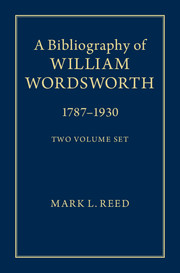Book contents
- Frontmatter
- Dedication
- Contents
- List of Figures
- Preface
- List of Abbreviations
- Introduction
- Bibliographic Procedures
- A Separate Single-author Books, Pamphlets, and Broadsides
- A Separate Single-author Books, Pamphlets, and Broadsides
- B First and Personally Contributed Printings in Separate Books and Pamphlets not Principally by Wordsworth
- C First and Personally Contributed Printings in Journals and Other Intermittent Publications not Books
- Appendices
Introduction
Published online by Cambridge University Press: 05 September 2013
- Frontmatter
- Dedication
- Contents
- List of Figures
- Preface
- List of Abbreviations
- Introduction
- Bibliographic Procedures
- A Separate Single-author Books, Pamphlets, and Broadsides
- A Separate Single-author Books, Pamphlets, and Broadsides
- B First and Personally Contributed Printings in Separate Books and Pamphlets not Principally by Wordsworth
- C First and Personally Contributed Printings in Journals and Other Intermittent Publications not Books
- Appendices
Summary
William Wordsworth lived from 1770 to 1850 and published his writings from 1787 to 1850. During those years the technology of printing developed from hand-set type, reset for most reprints, to stereotype, which required just one setting for as many printings as desired, and from hand press to machine press. Hand manufacture of paper was largely replaced by machine manufacture; and paper board trade bindings were replaced by publishers' prefabricated edition bindings, mainly in cloth. An economy fed by other developing technologies expanded along with population through Wordsworth's life and after, and within the population expanded education. Audiences for printed matter of every sort and subject – and so the businesses of printing and publishing to supply the market – grew in scale and complexity; and with them the audiences and suppliers and markets of belletristic printings and publications in general and of poetry in particular. So evolved some of the great changes in Western culture that the Romantics and their writings lived in and through, and interpreted, and prophesied, or provided temporary escape from, for contemporary and future readers. Wordsworth, the longest-lived of the major firstgeneration Romantics, lived through more of them than most of his peers.
Wordsworth grew on his own the while: in literary and ethical stature from aspirant to luminary and, for many, revered master; and in sales, from small to, by most standards, impressive.
- Type
- Chapter
- Information
- A Bibliography of William Wordsworth1787–1930, pp. xcvii - cxvPublisher: Cambridge University PressPrint publication year: 2013

